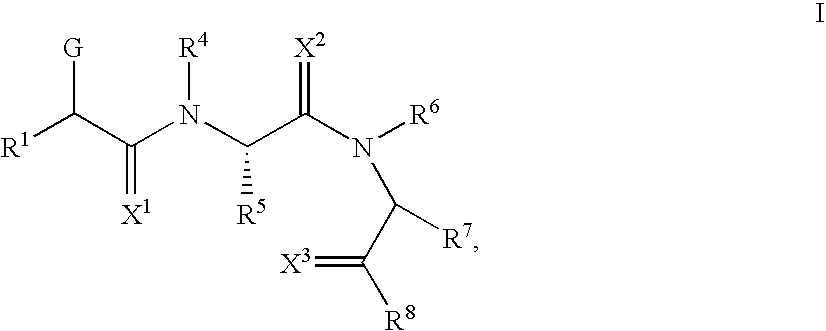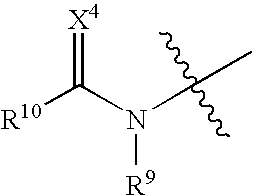Novel small molecule dnak inhibitors
a small molecule, inhibitor technology, applied in the direction of biocide, antibacterial agents, peptides, etc., can solve the problems of less than ideal antibacterial agents, pyrrhocoricin becomes highly susceptible to degradation, and peptides have an unacceptable toxic profile in animals, so as to prolong the activity, improve the antibacterial potential of small molecules and antibacterial agents, and reduce the necessary therapeutically effective dose
- Summary
- Abstract
- Description
- Claims
- Application Information
AI Technical Summary
Benefits of technology
Problems solved by technology
Method used
Image
Examples
example 1
Structure 1
[0163]
[0164]To synthesize Structure 1, rink amine AM resin (100 mg @ 0.68 mmol / g) was swollen and washed with 60:40 CH2Cl2 / DMF (3 ml) for periods of 10 minutes, and 2×90 minutes. The resin was subsequently washed with DMF (5×3 mL). The swollen resin was then subjected to five iterative cycles of the following automated peptide synthesis:
[0165]Resin was treated with 20% vv piperidine in DMF (3 mL) for 10 mins, filtered and retreated for 2×90 minutes. The resin was filtered and washed with DMF (5×3 mL). The resin was treated with an amino acid coupling cocktail comprising an Fmoc protected amino acid (4 eq, 1.07 mL of a 0.255 m DMA solution), PyBOP (4 eq, 1.60 mL of a 0.194 m DMA solution), HOBt (4 eq, 1.07 mL of a 0.255 m DMF solution), and DIEA (8 eq, 1.07 mL of a 0.51 m DMF solution). The resin was mixed for 3 hours, filtered and washed with DMF (3 mL) and the coupling process repeated twice. The resin was washed with DMF (3×3 mL) to complete one synthesis cycle. The Fmo...
example 2
Structure 2
[0167]
[0168]This structure was created by using a step-by-step synthesizing process. First Boc-Leu-Pro-OMe was synthesized using the following method. Proline methyl ester hydrochloride (322 mg, 2 mmol) and Boc-Leu-OH (2 mmol, 498 mg) dissolved in DMF (20 mL) and BOP (2 mmol, 884 mg) added with stifling. DIEA (14 mmol, 2.43 mL) was added dropwise and mixture stirred for 48 h. Reaction mixture quenched by addition to water (200 mL) and extracted with ethyl acetate (4×100 mL). Combined organic phases washed with water (3×150 mL), 2N hydrochloric acid (100 mL), saturated sodium bicarbonate solution (60 mL) and brine (60 mL), then dried over sodium sulfate. Evaporation of solvent gave a colorless oil (596 mg, 87%) which was used without further purification.
[0169]Next, Boc-Leu-Pro-OMe (596 mg, 1.75 mmol) was used to synthesize Boc-Tyr(Bzl)-Leu-Pro-OMe. Boc-Leu-Pro-OMe (596 mg, 1.75 mmol) was dissolved in CH2Cl2 (8 mL) and TFA (8 mL) added dropwise. After 30 min the volatile c...
example 3
Structure 3
[0171]
[0172]Structure 3 was synthesized using Ac-Tyr(Bzl)-Leu-Pro-OMe (454 mg, 0.85 mmol), which was synthesized using the method explained above. Ac-Tyr(Bzl)-Leu-Pro-OMe was then dissolved in THF (30 mL) and water (20 mL) added dropwise with stifling. Lithium hydroxide monohydrate (12 eq) was added and stifling continued for 4 h. The THF was removed on a rotary evaporator and the remaining aqueous solution diluted to 50 mL with water. 2N Hydrochloric acid (24 eq) was added dropwise and the resulting white solid collected by filtration, and washed with water (3×30 mL). Drying under vacuum gave the desired carboxylic acid (393 mg, 89%): 1H NMR (DMSO d6) δ=12.41 (br s, 1H), 8.11 (d, J=8.6 Hz, 1H), 7.96 (d, J=8.6 Hz, 1H), 7.45-7.29 (m, 5H), 7.13 (d, J=8.8 Hz, 2H), 6.87 (d, J=8.8 Hz, 2H), 5.04 (s, 2H), 4.52 (m, 1H), 4.45 (m, 1H), 4.21 (dd, J=5.0, 9.5 Hz, 1H), 3.64 (m, 1H), 3.46 (m, 1H), 2.87 (dd, J=3.9, 13.0 Hz, 1H), 2.61 (dd, J=10.1, 13.7 Hz, 1H), 2.12 (m, 1H), 1.85 (m, 3H),...
PUM
| Property | Measurement | Unit |
|---|---|---|
| structure | aaaaa | aaaaa |
| ring structure | aaaaa | aaaaa |
| bacterial resistance | aaaaa | aaaaa |
Abstract
Description
Claims
Application Information
 Login to View More
Login to View More - R&D
- Intellectual Property
- Life Sciences
- Materials
- Tech Scout
- Unparalleled Data Quality
- Higher Quality Content
- 60% Fewer Hallucinations
Browse by: Latest US Patents, China's latest patents, Technical Efficacy Thesaurus, Application Domain, Technology Topic, Popular Technical Reports.
© 2025 PatSnap. All rights reserved.Legal|Privacy policy|Modern Slavery Act Transparency Statement|Sitemap|About US| Contact US: help@patsnap.com



